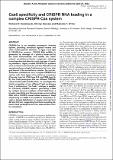Cas6 specificity and CRISPR RNA loading in a complex CRISPR-Cas system
View/
Date
02/06/2014Grant ID
BB/K000314/1
BB/M000400/1
BB/J005665/1
Metadata
Show full item recordAbstract
CRISPR-Cas is an adaptive prokaryotic immune system, providing protection against viruses and other mobile genetic elements. In type I and type III CRISPR-Cas systems, CRISPR RNA (crRNA) is generated by cleavage of a primary transcript by the Cas6 endonuclease and loaded into multisubunit surveillance/effector complexes, allowing homology-directed detection and cleavage of invading elements. Highly studied CRISPR-Cas systems such as those in Escherichia coli and Pseudomonas aeruginosa have a single Cas6 enzyme that is an integral subunit of the surveillance complex. By contrast, Sulfolobus solfataricus has a complex CRISPR-Cas system with three types of surveillance complexes (Cascade/type I-A, CSM/type III-A and CMR/type III-B), five Cas6 paralogues and two different CRISPR-repeat families (AB and CD). Here, we investigate the kinetic properties of two different Cas6 paralogues from S. solfataricus. The Cas6-1 subtype is specific for CD-family CRISPR repeats, generating crRNA by multiple turnover catalysis whilst Cas6-3 has a broader specificity and also processes a non-coding RNA with a CRISPR repeat-related sequence. Deep sequencing of crRNA in surveillance complexes reveals a biased distribution of spacers derived from AB and CD loci, suggesting functional coupling between Cas6 paralogues and their downstream effector complexes.
Citation
Sokolowski , R D , Graham , S & White , M F 2014 , ' Cas6 specificity and CRISPR RNA loading in a complex CRISPR-Cas system ' , Nucleic Acids Research , vol. 42 , no. 10 , pp. 6532-6541 . https://doi.org/10.1093/nar/gku308
Publication
Nucleic Acids Research
Status
Peer reviewed
ISSN
0305-1048Type
Journal article
Description
This research was funded in part by Biotechnology and Biological Sciences Research Council [BB/K000314/1]. The APC was paid through RCUK OA block grant funds.Collections
Items in the St Andrews Research Repository are protected by copyright, with all rights reserved, unless otherwise indicated.

